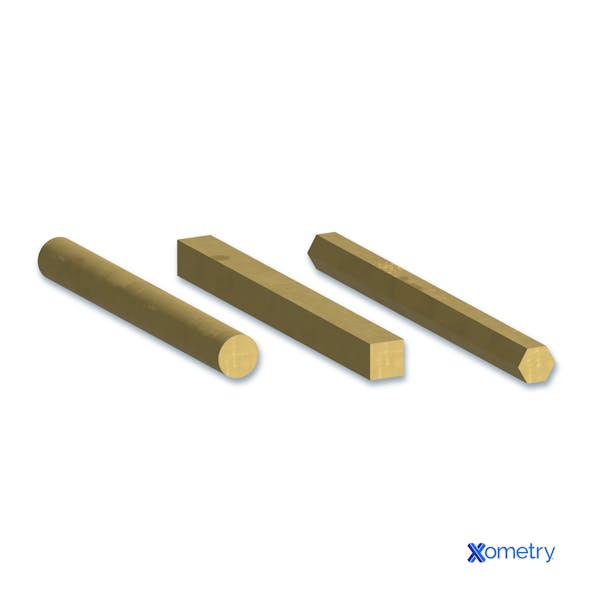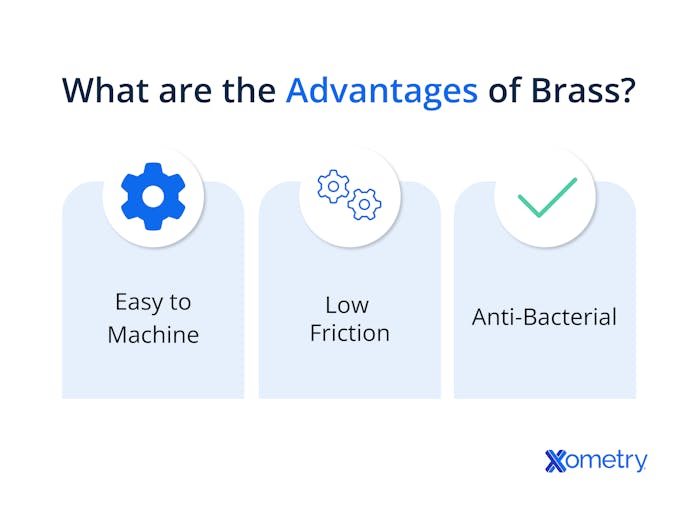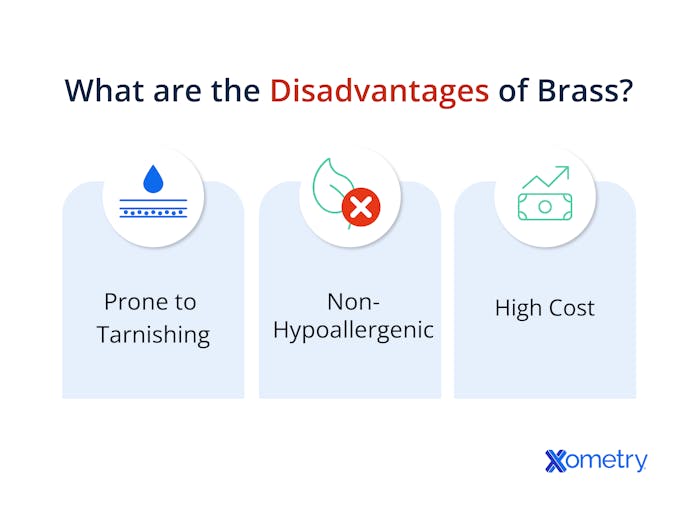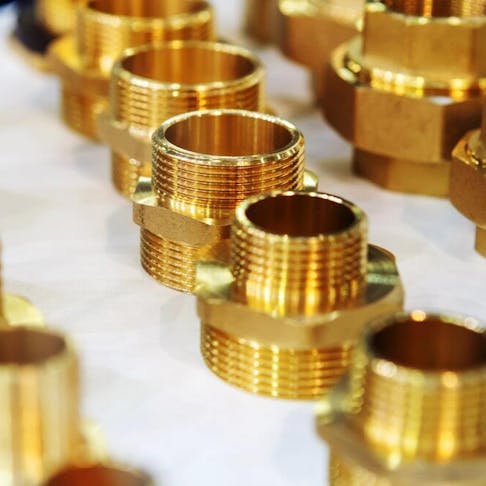Brass is an antibacterial and seawater-resistant metal alloy that’s easy to machine. This metal is mainly made up of copper and zinc, but it also has trace amounts of lead, iron, and other elements in it. In 2023, the USA was the fourth largest exporter of brass in the world with a total export value of almost $22 billion. The largest was Chile ($40 billion), followed by Germany ($29 billion) and Japan ($24.7 billion).
This article will discuss what brass is and the various types of brass, as well as their mechanical and chemical properties. Figure 1 below shows some brass bars:

What is Brass?
Brass is a workable, machinable, antibacterial, and anti-biofouling material. As briefly covered in our intro, brass is a metal alloy of copper and zinc that typically has a golden-yellow color but if the alloy has a lot of copper in it, it could sport a reddish hue. This type is called “red brass.” The exact quantities of copper and zinc (or other alloying elements) in the brass will determine its type and properties. Lead in brass will improve its corrosion resistance and machinability, and including iron will make it harder and easier to forge.
What Are the Components of Brass?
Brass is an alloy of zinc and copper. The exact quantities of copper and zinc will determine the type of brass and its relevant properties. Additional alloying elements can be added to the blend to improve specific properties. For example, lead improves corrosion resistance and machinability, whereas iron increases the hardness and makes the alloy easier to forge.
What Are the Different Types of Brass?
There are many brass alloys and they differ in their elemental makeup. Here are some of the most commonly used ones.
- Alloy 260 (Cartridge Brass): This has around 70% copper and 30% zinc with impurities. This alloy has excellent hot formability and is readily cold-worked.
- Alloy 280 (Muntz Brass / Muntz Metal): This brass alloy contains approximately 60% copper and 40% zinc, as well as trace amounts of iron. A common application for Muntz metal was as a less expensive replacement for the copper sheeting formerly placed on boat hulls to prevent the growth of sea organisms such as barnacles on the hulls.
- Alloy C360 (Free Machining Brass): This brass alloy contains approximately 60% copper, 35.5% zinc, up to 3.7% lead, and trace quantities of iron. This alloy is one of the easiest materials of all the brasses to machine and is classified as having a 100% machinability rating. It’s commonly used for parts like gears and bushings.
- Alloy 385 (Architectural Bronze): Despite being called bronze, 385 brass has around 59% copper, 42% zinc, and up to 3.5% lead in it. This mixture makes it more machinabile and formabile, which is why it’s popular in architecture for aluminum extrusions.
- Brass 464 Marine Grade (Naval Brass): This brass alloy contains approximately 59% copper, 40% percent zinc, and 1% tin, with a small amount of lead. The combination produces a metal with exceptional corrosion resistance to seawater. Applications can include the various fittings found on the deck of a boat.
What Are the Properties of Brass?
Table 1 below lists the mechanical and elemental makeup of the more common brass alloys. Many of these alloys instant quote on Xometry’s platform as a manufacturing material option.
| . | Alloy 260 | Alloy 280 | Alloy 360 | Alloy 385 | Alloy 464 |
|---|---|---|---|---|---|
. Composition (wt %) | Alloy 260 Cu: 68.5 - 71.5 Zn: 28.5 - 31.5 Fe <= 0.05 Pb <= 0.070 | Alloy 280 Cu: 59 - 63 Zn: 40 Fe <= 0.070 Pb <= 0.3 | Alloy 360 Cu: 60-63 Zn: 35.5 Fe <= 0.35 Pb <= 2.5-3.7 | Alloy 385 Cu: 55 - 59 Zn: 36.65-41.65 Fe <= 0.35 Pb <= 2.5-3.5 | Alloy 464 Cu: 55 - 59 Zn: 36.65 - 41.65 Zn Fe <= 0.35 Pb <= 2.5-3.5 |
. Density (g/cm3) | Alloy 260 8.53 | Alloy 280 8.39 | Alloy 360 8.49 | Alloy 385 8.47 | Alloy 464 8.41 |
. Hardness, Rockwell (F, B) | Alloy 260 54 F | Alloy 280 85 F | Alloy 360 78 B | Alloy 385 65 B | Alloy 464 55 B |
. Yield Strength (MPa) | Alloy 260 75 | Alloy 280 145 | Alloy 360 124-310 | Alloy 385 138 | Alloy 464 172-455 |
. Ultimate Tensile Strength (MPa) | Alloy 260 300 | Alloy 280 370 | Alloy 360 338-469 | Alloy 385 414 | Alloy 464 379-607 |
. Elongation @ Break (%) | Alloy 260 68 | Alloy 280 45 | Alloy 360 53 | Alloy 385 30 | Alloy 464 50 |
. Modulus of Elasticity (GPa) | Alloy 260 110 | Alloy 280 105 | Alloy 360 97 | Alloy 385 - | Alloy 464 100 |
. Machinability (%) | Alloy 260 30 | Alloy 280 40 | Alloy 360 100 | Alloy 385 90 | Alloy 464 30 |
Table Credit: https://matweb.com/
Where Is Brass Made?
The European Union was the largest exporter of brass in 2021, with a total product value of 163 million USD. India and South Korea are the next largest exporters of brass.
What Are the Applications of Brass?
Brass is used in many industries because it’s so easy to work with, corrosion resistant, and has antibacterial properties. It can be made into many products, from bullet cartridges, gears, tools, valves, and pipes and fittings, to door handles and hinges, marine engines, and even musical instruments.
What Are the Advantages of Brass?
Brass has many advantages. In addition to being one of the easiest materials to machine (free-machining brass has an 100% machinability rating), it also has a low coefficient of friction (in layman’s terms, its surface is very smooth and slippery, which makes it great for parts that need to slide against each other without wearing down quickly). The copper content in brass can kill certain types of bacteria, making it the go-to for things for high-touch surfaces like door handles. It’s also used in marine industries thanks to its biofouling properties, meaning that algae and barnacles won’t grow on it.

What Are the Disadvantages of Brass?
Brass’s main disadvantage is that it’s prone to tarnishing; if it’s not properly maintained, it can form unsightly blackish stains due to oxidation. To prevent this, many coat the material with a clear lacquer. It’s also non-hypoallergenic (you can thank the copper and zinc for that) and can cause some skin irritation to people with sensitive skin. Again, treating it with a lacquer coating could prevent this. Finally, its high copper content makes it more expensive than other metals (copper is notoriously pricey).

| Brass Grade | Solidus Melting Point (°C) | Liquidus Melting Point (°C) |
|---|---|---|
Brass Grade Alloy 260 | Solidus Melting Point (°C) 915 | Liquidus Melting Point (°C) 955 |
Brass Grade Alloy 280 | Solidus Melting Point (°C) 900 | Liquidus Melting Point (°C) 905 |
Brass Grade Alloy 360 | Solidus Melting Point (°C) 885 | Liquidus Melting Point (°C) 900 |
Brass Grade Alloy 385 | Solidus Melting Point (°C) 875 | Liquidus Melting Point (°C) 890 |
Brass Grade Alloy 464 | Solidus Melting Point (°C) 885 | Liquidus Melting Point (°C) 900 |
Table Credit: https://matweb.com/
How Strong is Brass?
Brass is quite strong and durable but the level of its strength depends on its composition and the type of heat treatment it has gone through. When naval brass is cold drawn and annealed, it gets a tensile strength of 580 MPa which is impressively as high as some steel grades. Brass that has been heat-treated is strong enough to be used for valve bodies that need to withstand high pressures.
Is Brass Safe to Use?
Yes, brass is safe to use for general engineering applications but is not recommended when coming into contact with acidic food (pH < 6). Brass is toxic to some microscopic organic life due to the negative effect of copper ions on various microscopic living organisms. Brass can also prompt an allergic reaction in persons with skin sensitivity.
Does Brass Violate REACH or RoHS?
Copper Alloys such as brass and bronze (which contain Lead) in their solid form and under normal conditions do not violate REACH (REACH is about inhaling, ingestion, or contact health hazards). Xometry would only ship final products and therefore do not present any hazards. The hazards are generated during welding, heating, and dust generation activities, such as machining.
The lead content in brass has a special exemption in RoHS (Exemption 6c) which allows brass to contain up to 4% lead by weight. Note that not all brass alloys qualify so it’s important to communicate RoHS or REACH requirements during the quoting phase of a project to ensure material compliance in manufacturing. You can learn about Xometry’s REACH/RoHS Declaration here.
Copper vs. Brass vs. Bronze
All three of these are commonly referred to as “red metals.” Brass and bronze contain copper as their main element. Brass contains zinc as the main secondary element, while bronze typically has tin. Bronze is especially resistant to corrosion from seawater whereas brass has excellent low-friction capabilities. Copper is great for electrical applications like wiring or busbars due to its high conductivity.
Frequently Asked Questions About Brass
How Strong is Brass?
Brass is quite strong and durable but the level of its strength depends on its composition and the type of heat treatment it has gone through. When naval brass is cold drawn and annealed, it gets a tensile strength of 580 MPa which is impressively as high as some steel grades. Brass that has been heat-treated is strong enough to be used for valve bodies that need to withstand high pressures.
Is Brass Safe to Use?
Yes, brass is safe to use for general engineering applications but is not recommended when coming into contact with acidic food (pH < 6). Brass is toxic to some microscopic organic life due to the negative effect of copper ions on various microscopic living organisms. Brass can also prompt an allergic reaction in persons with skin sensitivity.
Does Brass Violate REACH or RoHS?
Copper Alloys such as brass and bronze (which contain Lead) in their solid form and under normal conditions do not violate REACH (REACH is about inhaling, ingestion, or contact health hazards). Xometry would only ship final products and therefore do not present any hazards. The hazards are generated during welding, heating, and dust generation activities, such as machining.
The lead content in brass has a special exemption in RoHS (Exemption 6c) which allows brass to contain up to 4% lead by weight. Note that not all brass alloys qualify so it’s important to communicate RoHS or REACH requirements during the quoting phase of a project to ensure material compliance in manufacturing. You can learn about Xometry’s REACH/RoHS Declaration here.
What Is the Difference Between Copper, Brass, and Bronze?
All three of these are commonly referred to as “red metals.” Brass and bronze contain copper as their main element. Brass contains zinc as the main secondary element, while bronze typically has tin. Bronze is especially resistant to corrosion from seawater whereas brass has excellent low-friction capabilities. Copper is great for electrical applications like wiring or busbars due to its high conductivity.
How Can Xometry Help?
We hope you enjoyed learning all about brass with us, and found the answers to any questions you may have had about this interesting metal alloy. If you're working on a manufacturing project, Xometry provides a wide range of manufacturing capabilities and other value-added services for all of your prototyping and production needs. Get started by uploading your files to get a free, no-obligation quote.
Disclaimer
The content appearing on this webpage is for informational purposes only. Xometry makes no representation or warranty of any kind, be it expressed or implied, as to the accuracy, completeness, or validity of the information. Any performance parameters, geometric tolerances, specific design features, quality and types of materials, or processes should not be inferred to represent what will be delivered by third-party suppliers or manufacturers through Xometry’s network. Buyers seeking quotes for parts are responsible for defining the specific requirements for those parts. Please refer to our terms and conditions for more information.

